IB Report: Analyzing India's Business Factors for Foreign Investment
VerifiedAdded on 2023/05/28
|12
|3001
|54
Report
AI Summary
This report provides an analysis of the external business factors influencing Foreign Direct Investment (FDI) in India. It examines political, economic, social, and technological factors, identifying both positive and negative aspects of the Indian business environment. The report also highlights India's competitive advantages, such as abundant natural resources and low production costs. It addresses foreign currency exchange influences and trade policies, including barriers and incentives for foreign investors. The report concludes with recommendations for the Indian government to further enhance its attractiveness as an investment destination, such as streamlining the business approval process and improving infrastructure. The existing levels of foreign investment are also discussed, showcasing India's potential for growth in this area.
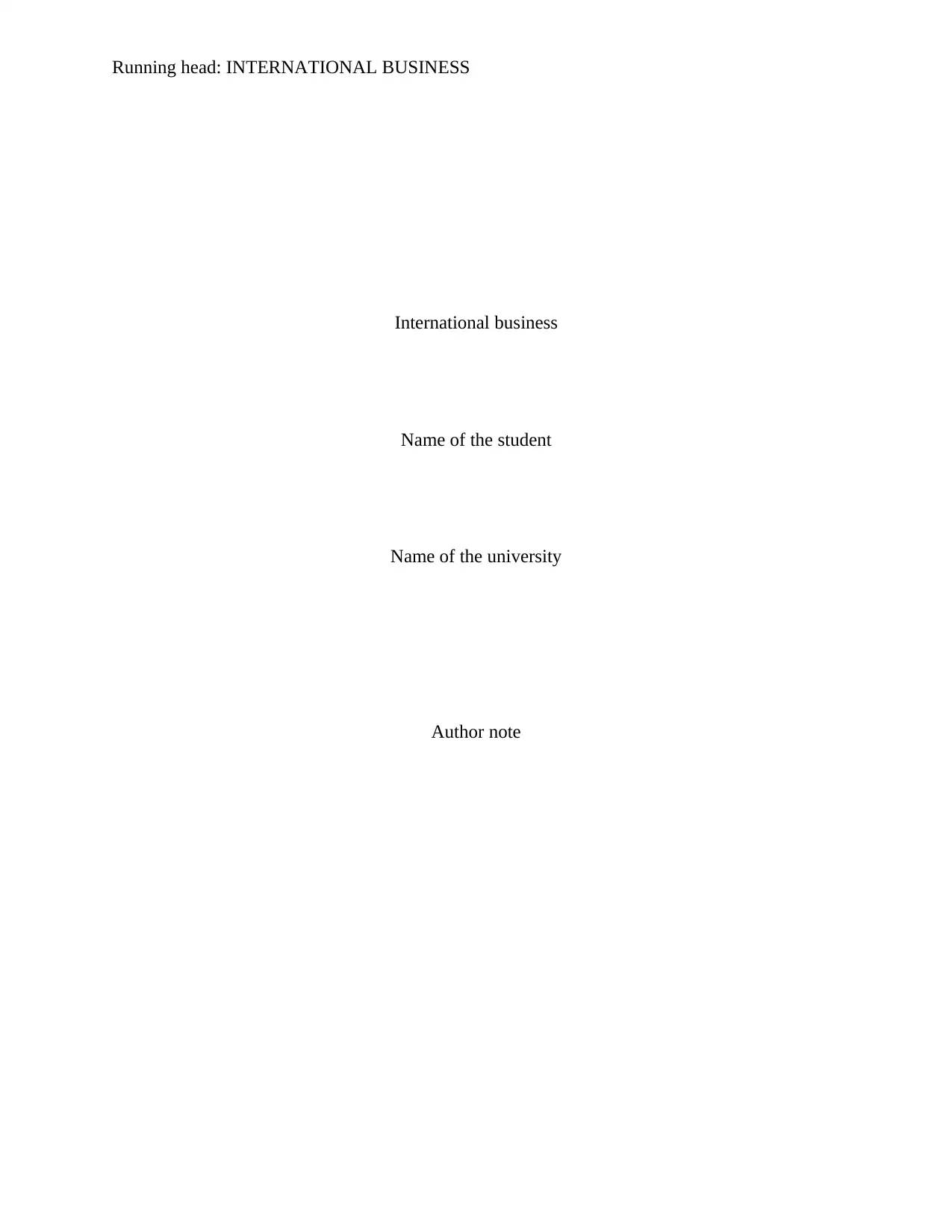
Running head: INTERNATIONAL BUSINESS
International business
Name of the student
Name of the university
Author note
International business
Name of the student
Name of the university
Author note
Paraphrase This Document
Need a fresh take? Get an instant paraphrase of this document with our AI Paraphraser
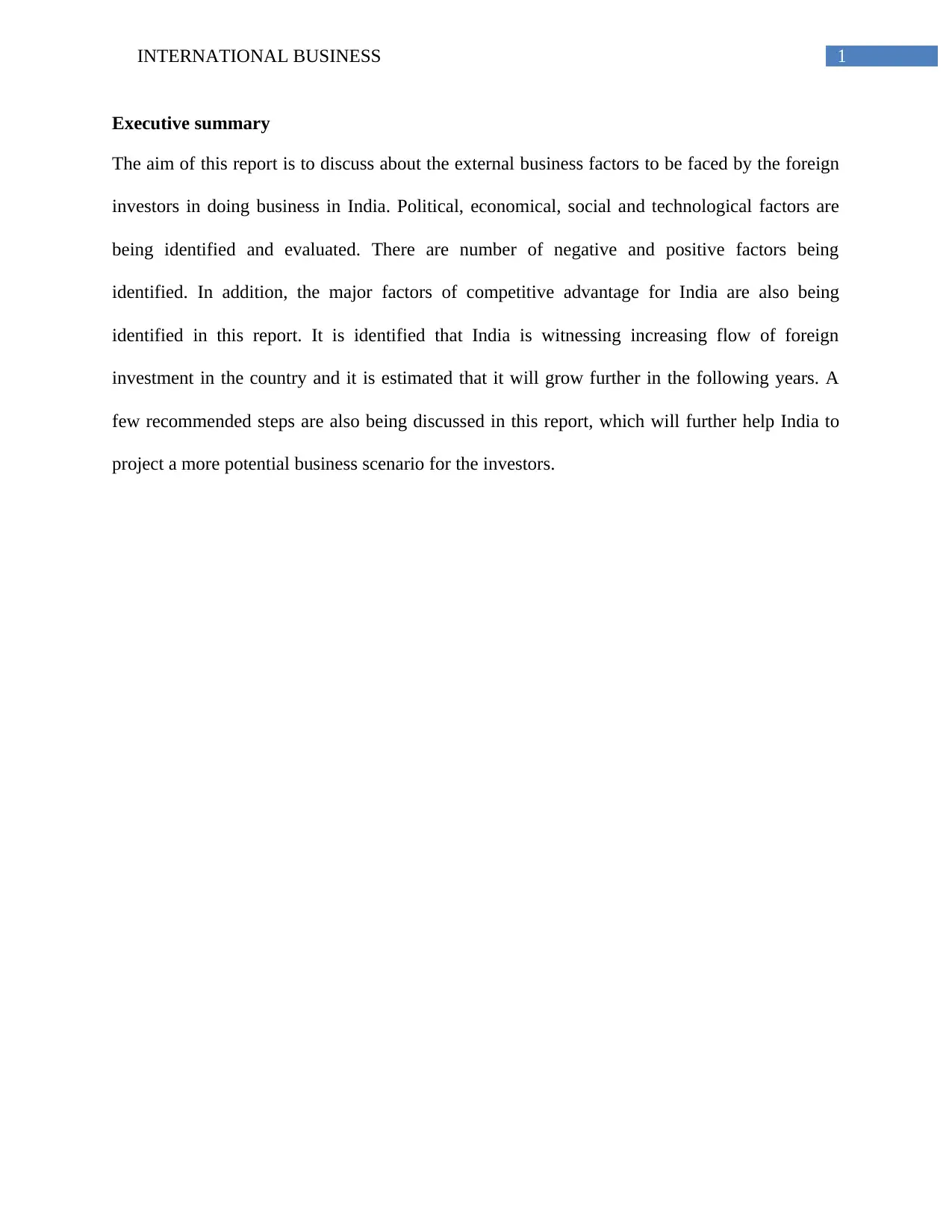
1INTERNATIONAL BUSINESS
Executive summary
The aim of this report is to discuss about the external business factors to be faced by the foreign
investors in doing business in India. Political, economical, social and technological factors are
being identified and evaluated. There are number of negative and positive factors being
identified. In addition, the major factors of competitive advantage for India are also being
identified in this report. It is identified that India is witnessing increasing flow of foreign
investment in the country and it is estimated that it will grow further in the following years. A
few recommended steps are also being discussed in this report, which will further help India to
project a more potential business scenario for the investors.
Executive summary
The aim of this report is to discuss about the external business factors to be faced by the foreign
investors in doing business in India. Political, economical, social and technological factors are
being identified and evaluated. There are number of negative and positive factors being
identified. In addition, the major factors of competitive advantage for India are also being
identified in this report. It is identified that India is witnessing increasing flow of foreign
investment in the country and it is estimated that it will grow further in the following years. A
few recommended steps are also being discussed in this report, which will further help India to
project a more potential business scenario for the investors.
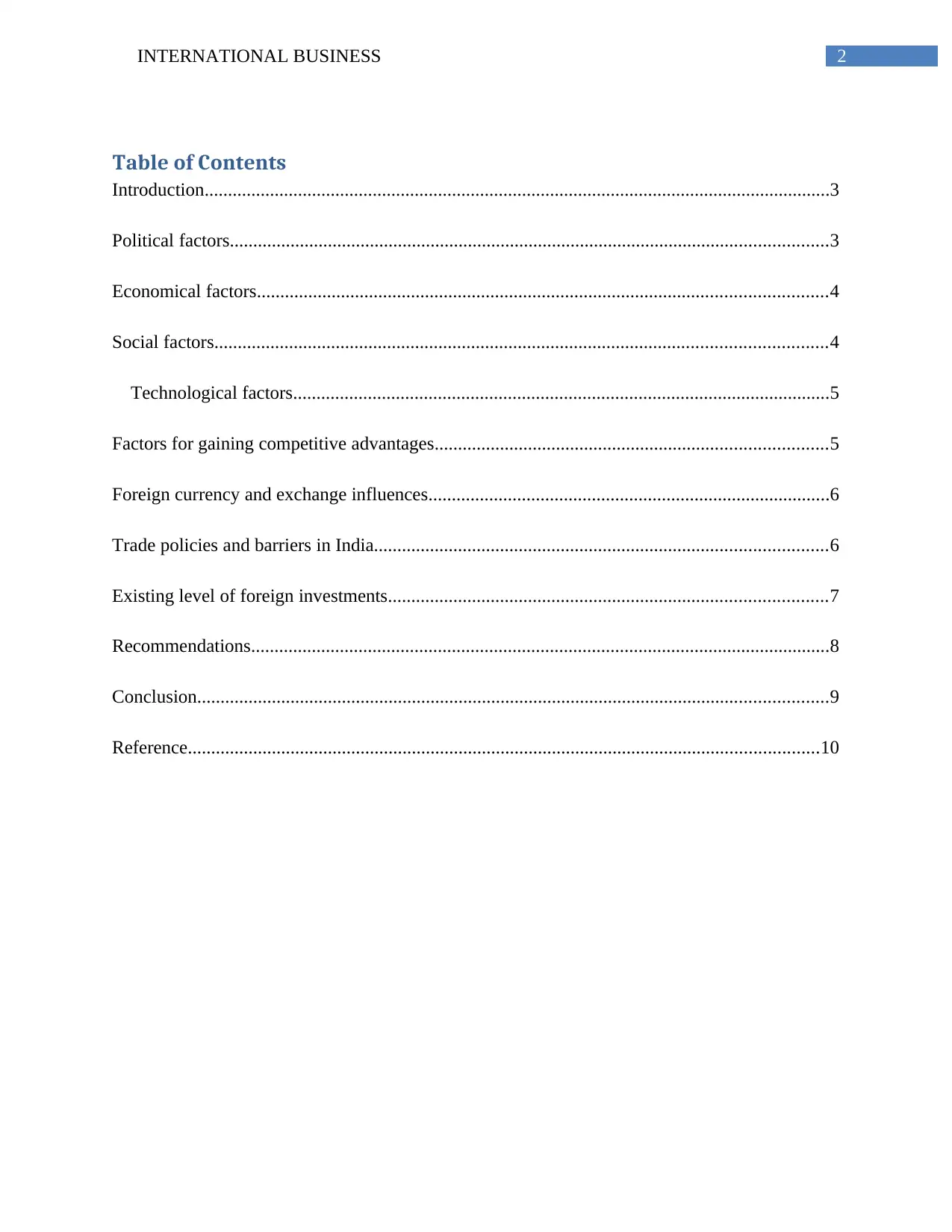
2INTERNATIONAL BUSINESS
Table of Contents
Introduction......................................................................................................................................3
Political factors................................................................................................................................3
Economical factors..........................................................................................................................4
Social factors...................................................................................................................................4
Technological factors...................................................................................................................5
Factors for gaining competitive advantages....................................................................................5
Foreign currency and exchange influences......................................................................................6
Trade policies and barriers in India.................................................................................................6
Existing level of foreign investments..............................................................................................7
Recommendations............................................................................................................................8
Conclusion.......................................................................................................................................9
Reference.......................................................................................................................................10
Table of Contents
Introduction......................................................................................................................................3
Political factors................................................................................................................................3
Economical factors..........................................................................................................................4
Social factors...................................................................................................................................4
Technological factors...................................................................................................................5
Factors for gaining competitive advantages....................................................................................5
Foreign currency and exchange influences......................................................................................6
Trade policies and barriers in India.................................................................................................6
Existing level of foreign investments..............................................................................................7
Recommendations............................................................................................................................8
Conclusion.......................................................................................................................................9
Reference.......................................................................................................................................10
⊘ This is a preview!⊘
Do you want full access?
Subscribe today to unlock all pages.

Trusted by 1+ million students worldwide
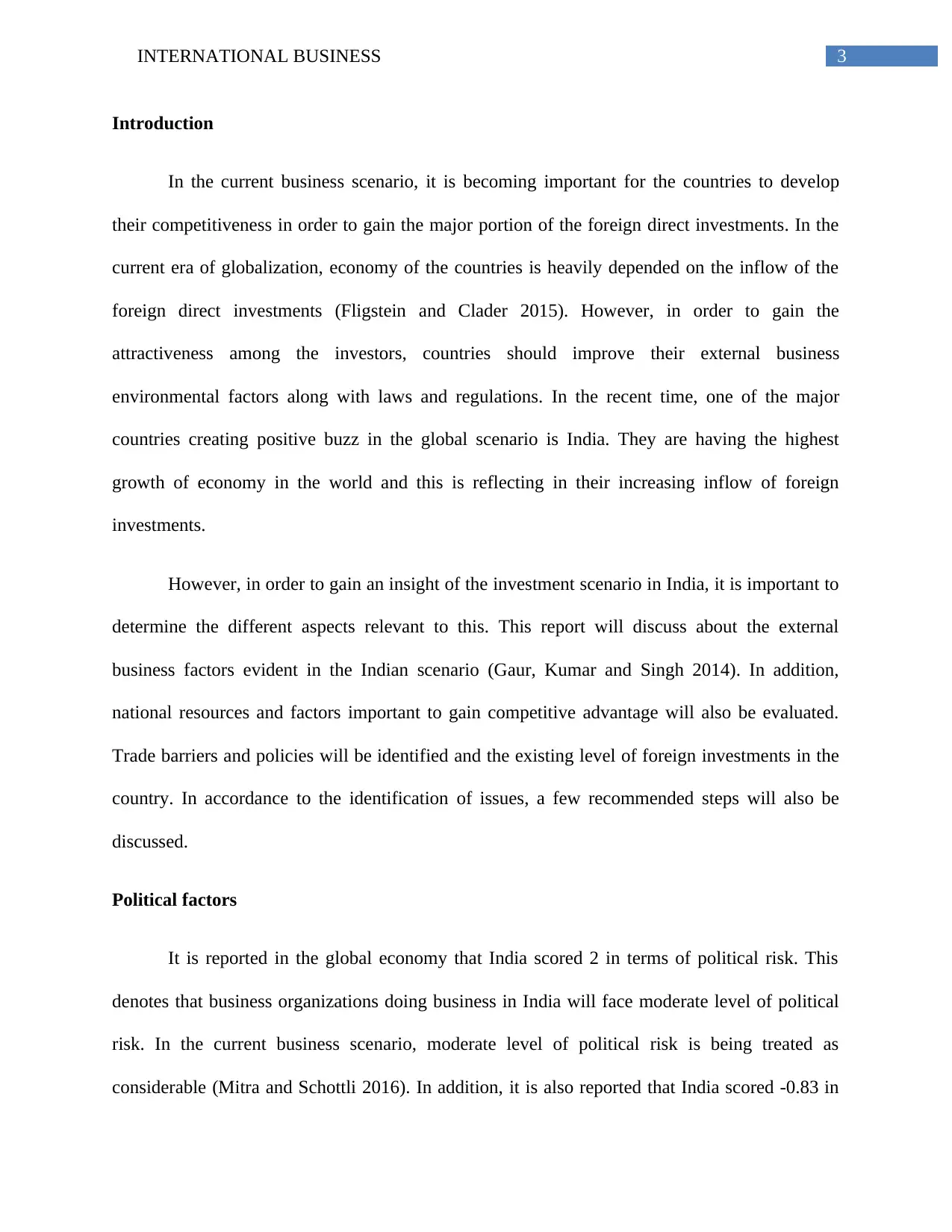
3INTERNATIONAL BUSINESS
Introduction
In the current business scenario, it is becoming important for the countries to develop
their competitiveness in order to gain the major portion of the foreign direct investments. In the
current era of globalization, economy of the countries is heavily depended on the inflow of the
foreign direct investments (Fligstein and Clader 2015). However, in order to gain the
attractiveness among the investors, countries should improve their external business
environmental factors along with laws and regulations. In the recent time, one of the major
countries creating positive buzz in the global scenario is India. They are having the highest
growth of economy in the world and this is reflecting in their increasing inflow of foreign
investments.
However, in order to gain an insight of the investment scenario in India, it is important to
determine the different aspects relevant to this. This report will discuss about the external
business factors evident in the Indian scenario (Gaur, Kumar and Singh 2014). In addition,
national resources and factors important to gain competitive advantage will also be evaluated.
Trade barriers and policies will be identified and the existing level of foreign investments in the
country. In accordance to the identification of issues, a few recommended steps will also be
discussed.
Political factors
It is reported in the global economy that India scored 2 in terms of political risk. This
denotes that business organizations doing business in India will face moderate level of political
risk. In the current business scenario, moderate level of political risk is being treated as
considerable (Mitra and Schottli 2016). In addition, it is also reported that India scored -0.83 in
Introduction
In the current business scenario, it is becoming important for the countries to develop
their competitiveness in order to gain the major portion of the foreign direct investments. In the
current era of globalization, economy of the countries is heavily depended on the inflow of the
foreign direct investments (Fligstein and Clader 2015). However, in order to gain the
attractiveness among the investors, countries should improve their external business
environmental factors along with laws and regulations. In the recent time, one of the major
countries creating positive buzz in the global scenario is India. They are having the highest
growth of economy in the world and this is reflecting in their increasing inflow of foreign
investments.
However, in order to gain an insight of the investment scenario in India, it is important to
determine the different aspects relevant to this. This report will discuss about the external
business factors evident in the Indian scenario (Gaur, Kumar and Singh 2014). In addition,
national resources and factors important to gain competitive advantage will also be evaluated.
Trade barriers and policies will be identified and the existing level of foreign investments in the
country. In accordance to the identification of issues, a few recommended steps will also be
discussed.
Political factors
It is reported in the global economy that India scored 2 in terms of political risk. This
denotes that business organizations doing business in India will face moderate level of political
risk. In the current business scenario, moderate level of political risk is being treated as
considerable (Mitra and Schottli 2016). In addition, it is also reported that India scored -0.83 in
Paraphrase This Document
Need a fresh take? Get an instant paraphrase of this document with our AI Paraphraser
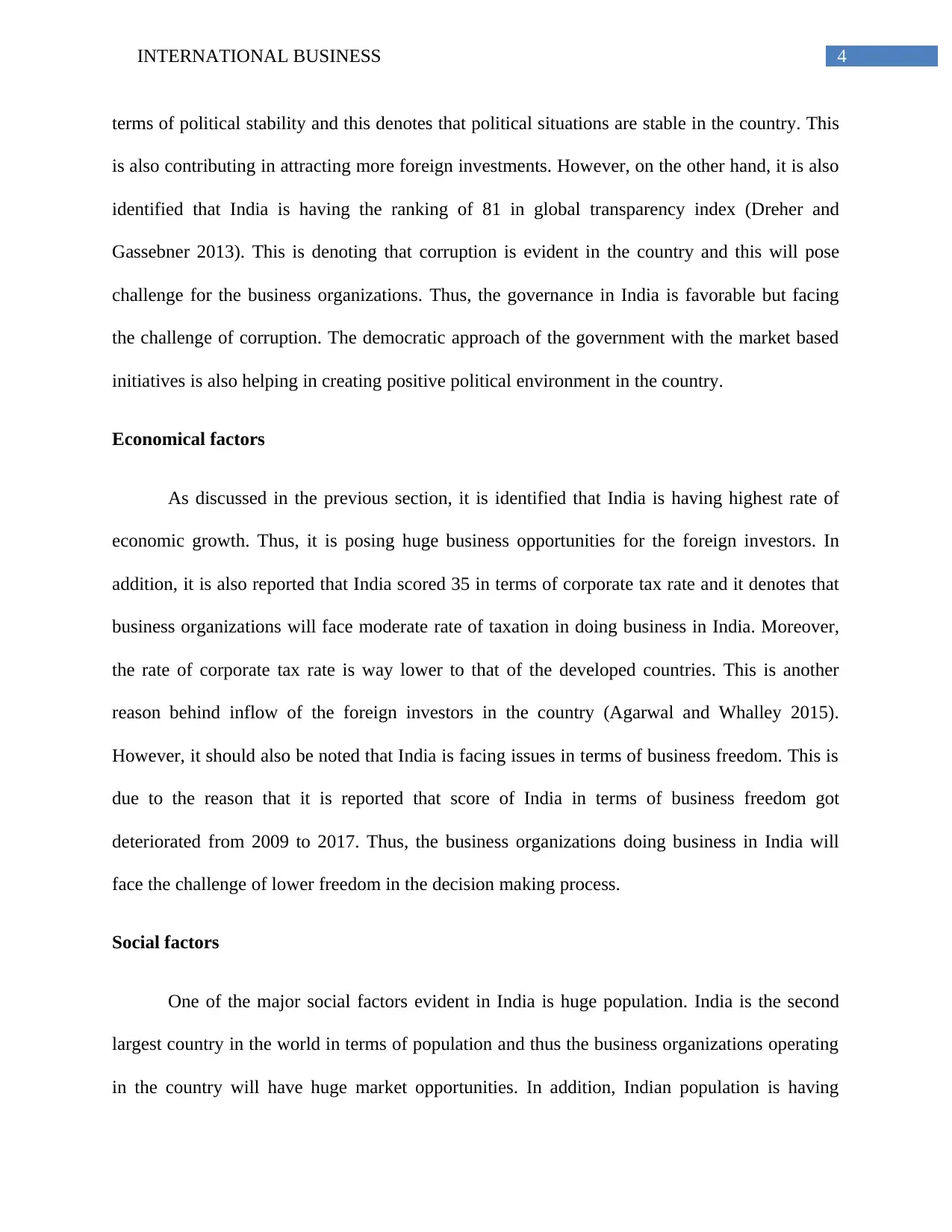
4INTERNATIONAL BUSINESS
terms of political stability and this denotes that political situations are stable in the country. This
is also contributing in attracting more foreign investments. However, on the other hand, it is also
identified that India is having the ranking of 81 in global transparency index (Dreher and
Gassebner 2013). This is denoting that corruption is evident in the country and this will pose
challenge for the business organizations. Thus, the governance in India is favorable but facing
the challenge of corruption. The democratic approach of the government with the market based
initiatives is also helping in creating positive political environment in the country.
Economical factors
As discussed in the previous section, it is identified that India is having highest rate of
economic growth. Thus, it is posing huge business opportunities for the foreign investors. In
addition, it is also reported that India scored 35 in terms of corporate tax rate and it denotes that
business organizations will face moderate rate of taxation in doing business in India. Moreover,
the rate of corporate tax rate is way lower to that of the developed countries. This is another
reason behind inflow of the foreign investors in the country (Agarwal and Whalley 2015).
However, it should also be noted that India is facing issues in terms of business freedom. This is
due to the reason that it is reported that score of India in terms of business freedom got
deteriorated from 2009 to 2017. Thus, the business organizations doing business in India will
face the challenge of lower freedom in the decision making process.
Social factors
One of the major social factors evident in India is huge population. India is the second
largest country in the world in terms of population and thus the business organizations operating
in the country will have huge market opportunities. In addition, Indian population is having
terms of political stability and this denotes that political situations are stable in the country. This
is also contributing in attracting more foreign investments. However, on the other hand, it is also
identified that India is having the ranking of 81 in global transparency index (Dreher and
Gassebner 2013). This is denoting that corruption is evident in the country and this will pose
challenge for the business organizations. Thus, the governance in India is favorable but facing
the challenge of corruption. The democratic approach of the government with the market based
initiatives is also helping in creating positive political environment in the country.
Economical factors
As discussed in the previous section, it is identified that India is having highest rate of
economic growth. Thus, it is posing huge business opportunities for the foreign investors. In
addition, it is also reported that India scored 35 in terms of corporate tax rate and it denotes that
business organizations will face moderate rate of taxation in doing business in India. Moreover,
the rate of corporate tax rate is way lower to that of the developed countries. This is another
reason behind inflow of the foreign investors in the country (Agarwal and Whalley 2015).
However, it should also be noted that India is facing issues in terms of business freedom. This is
due to the reason that it is reported that score of India in terms of business freedom got
deteriorated from 2009 to 2017. Thus, the business organizations doing business in India will
face the challenge of lower freedom in the decision making process.
Social factors
One of the major social factors evident in India is huge population. India is the second
largest country in the world in terms of population and thus the business organizations operating
in the country will have huge market opportunities. In addition, Indian population is having
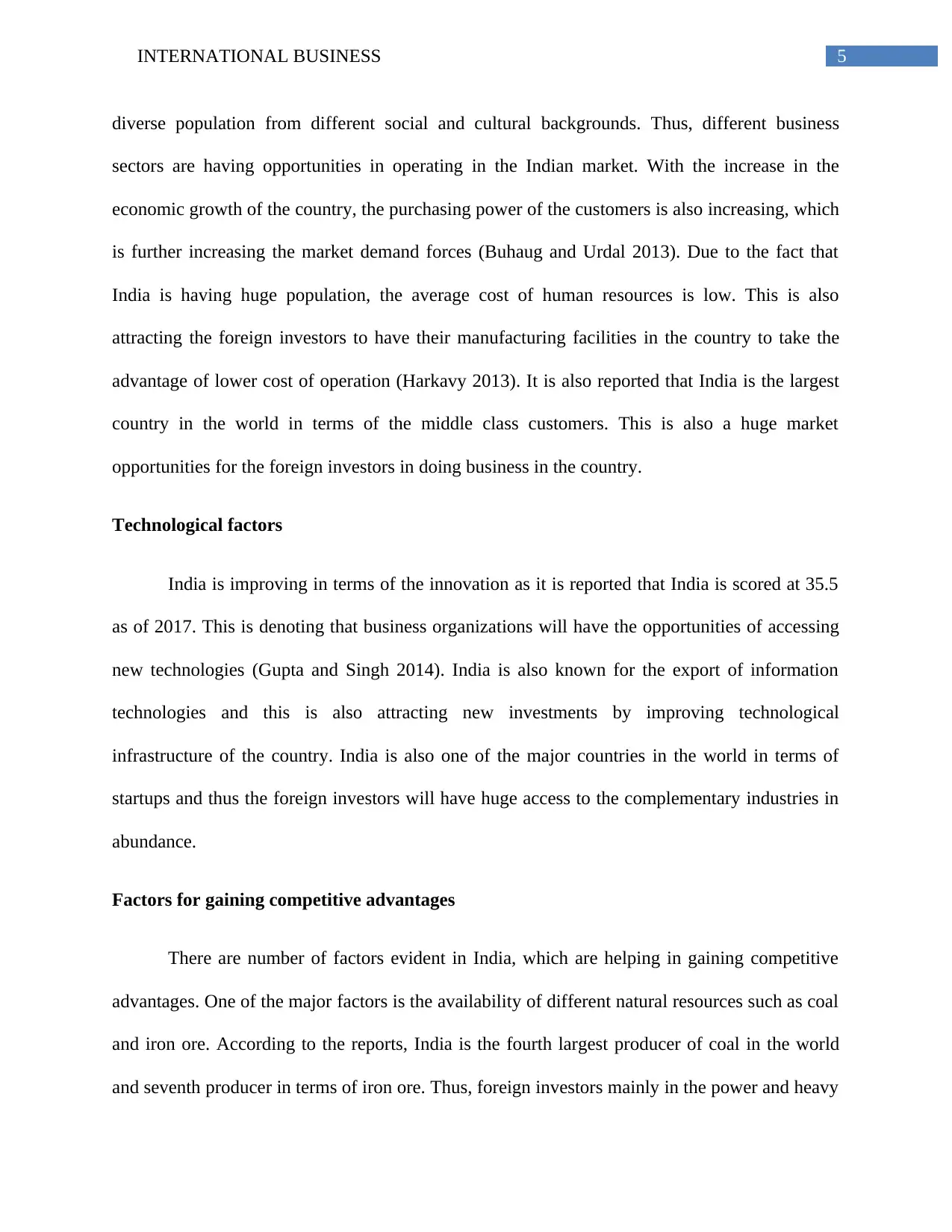
5INTERNATIONAL BUSINESS
diverse population from different social and cultural backgrounds. Thus, different business
sectors are having opportunities in operating in the Indian market. With the increase in the
economic growth of the country, the purchasing power of the customers is also increasing, which
is further increasing the market demand forces (Buhaug and Urdal 2013). Due to the fact that
India is having huge population, the average cost of human resources is low. This is also
attracting the foreign investors to have their manufacturing facilities in the country to take the
advantage of lower cost of operation (Harkavy 2013). It is also reported that India is the largest
country in the world in terms of the middle class customers. This is also a huge market
opportunities for the foreign investors in doing business in the country.
Technological factors
India is improving in terms of the innovation as it is reported that India is scored at 35.5
as of 2017. This is denoting that business organizations will have the opportunities of accessing
new technologies (Gupta and Singh 2014). India is also known for the export of information
technologies and this is also attracting new investments by improving technological
infrastructure of the country. India is also one of the major countries in the world in terms of
startups and thus the foreign investors will have huge access to the complementary industries in
abundance.
Factors for gaining competitive advantages
There are number of factors evident in India, which are helping in gaining competitive
advantages. One of the major factors is the availability of different natural resources such as coal
and iron ore. According to the reports, India is the fourth largest producer of coal in the world
and seventh producer in terms of iron ore. Thus, foreign investors mainly in the power and heavy
diverse population from different social and cultural backgrounds. Thus, different business
sectors are having opportunities in operating in the Indian market. With the increase in the
economic growth of the country, the purchasing power of the customers is also increasing, which
is further increasing the market demand forces (Buhaug and Urdal 2013). Due to the fact that
India is having huge population, the average cost of human resources is low. This is also
attracting the foreign investors to have their manufacturing facilities in the country to take the
advantage of lower cost of operation (Harkavy 2013). It is also reported that India is the largest
country in the world in terms of the middle class customers. This is also a huge market
opportunities for the foreign investors in doing business in the country.
Technological factors
India is improving in terms of the innovation as it is reported that India is scored at 35.5
as of 2017. This is denoting that business organizations will have the opportunities of accessing
new technologies (Gupta and Singh 2014). India is also known for the export of information
technologies and this is also attracting new investments by improving technological
infrastructure of the country. India is also one of the major countries in the world in terms of
startups and thus the foreign investors will have huge access to the complementary industries in
abundance.
Factors for gaining competitive advantages
There are number of factors evident in India, which are helping in gaining competitive
advantages. One of the major factors is the availability of different natural resources such as coal
and iron ore. According to the reports, India is the fourth largest producer of coal in the world
and seventh producer in terms of iron ore. Thus, foreign investors mainly in the power and heavy
⊘ This is a preview!⊘
Do you want full access?
Subscribe today to unlock all pages.

Trusted by 1+ million students worldwide
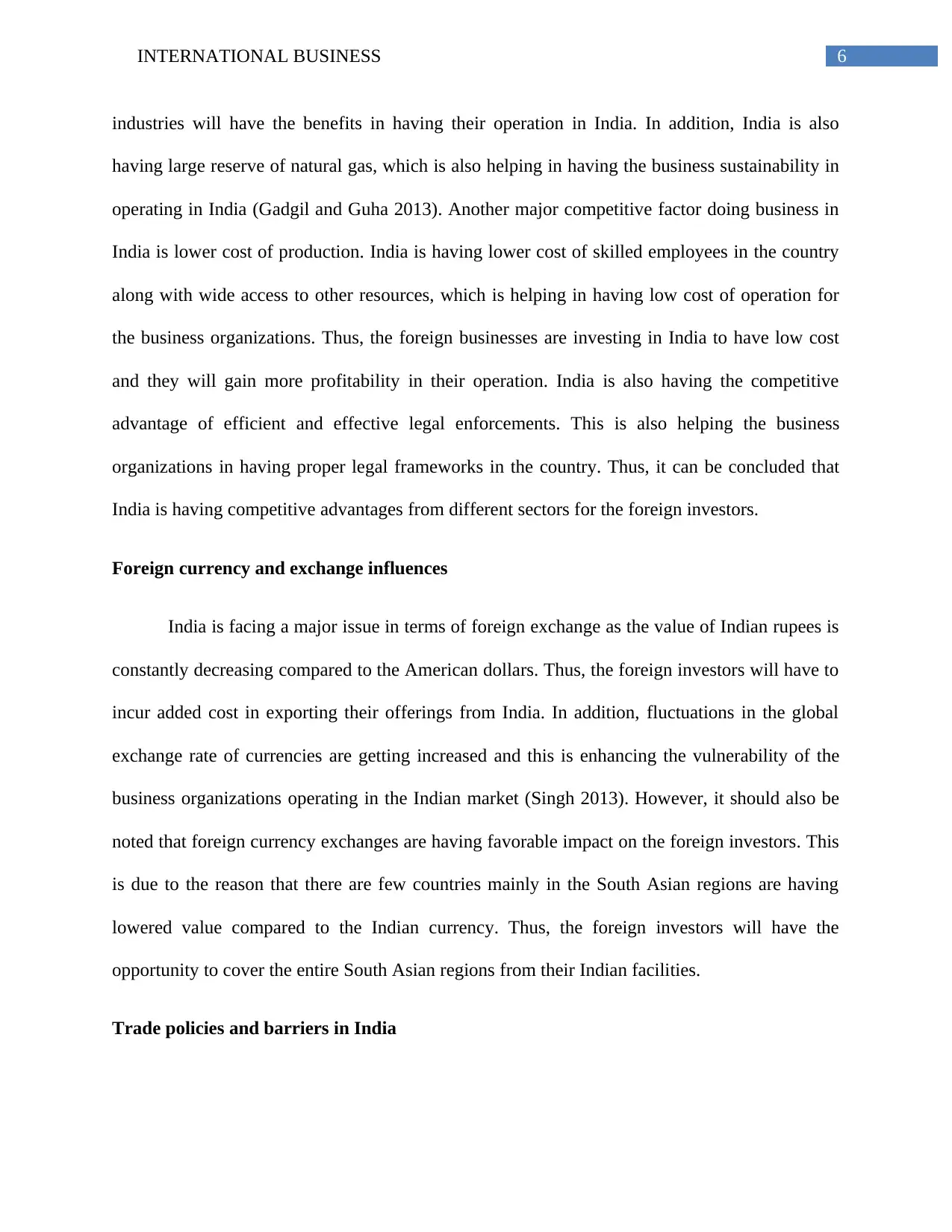
6INTERNATIONAL BUSINESS
industries will have the benefits in having their operation in India. In addition, India is also
having large reserve of natural gas, which is also helping in having the business sustainability in
operating in India (Gadgil and Guha 2013). Another major competitive factor doing business in
India is lower cost of production. India is having lower cost of skilled employees in the country
along with wide access to other resources, which is helping in having low cost of operation for
the business organizations. Thus, the foreign businesses are investing in India to have low cost
and they will gain more profitability in their operation. India is also having the competitive
advantage of efficient and effective legal enforcements. This is also helping the business
organizations in having proper legal frameworks in the country. Thus, it can be concluded that
India is having competitive advantages from different sectors for the foreign investors.
Foreign currency and exchange influences
India is facing a major issue in terms of foreign exchange as the value of Indian rupees is
constantly decreasing compared to the American dollars. Thus, the foreign investors will have to
incur added cost in exporting their offerings from India. In addition, fluctuations in the global
exchange rate of currencies are getting increased and this is enhancing the vulnerability of the
business organizations operating in the Indian market (Singh 2013). However, it should also be
noted that foreign currency exchanges are having favorable impact on the foreign investors. This
is due to the reason that there are few countries mainly in the South Asian regions are having
lowered value compared to the Indian currency. Thus, the foreign investors will have the
opportunity to cover the entire South Asian regions from their Indian facilities.
Trade policies and barriers in India
industries will have the benefits in having their operation in India. In addition, India is also
having large reserve of natural gas, which is also helping in having the business sustainability in
operating in India (Gadgil and Guha 2013). Another major competitive factor doing business in
India is lower cost of production. India is having lower cost of skilled employees in the country
along with wide access to other resources, which is helping in having low cost of operation for
the business organizations. Thus, the foreign businesses are investing in India to have low cost
and they will gain more profitability in their operation. India is also having the competitive
advantage of efficient and effective legal enforcements. This is also helping the business
organizations in having proper legal frameworks in the country. Thus, it can be concluded that
India is having competitive advantages from different sectors for the foreign investors.
Foreign currency and exchange influences
India is facing a major issue in terms of foreign exchange as the value of Indian rupees is
constantly decreasing compared to the American dollars. Thus, the foreign investors will have to
incur added cost in exporting their offerings from India. In addition, fluctuations in the global
exchange rate of currencies are getting increased and this is enhancing the vulnerability of the
business organizations operating in the Indian market (Singh 2013). However, it should also be
noted that foreign currency exchanges are having favorable impact on the foreign investors. This
is due to the reason that there are few countries mainly in the South Asian regions are having
lowered value compared to the Indian currency. Thus, the foreign investors will have the
opportunity to cover the entire South Asian regions from their Indian facilities.
Trade policies and barriers in India
Paraphrase This Document
Need a fresh take? Get an instant paraphrase of this document with our AI Paraphraser
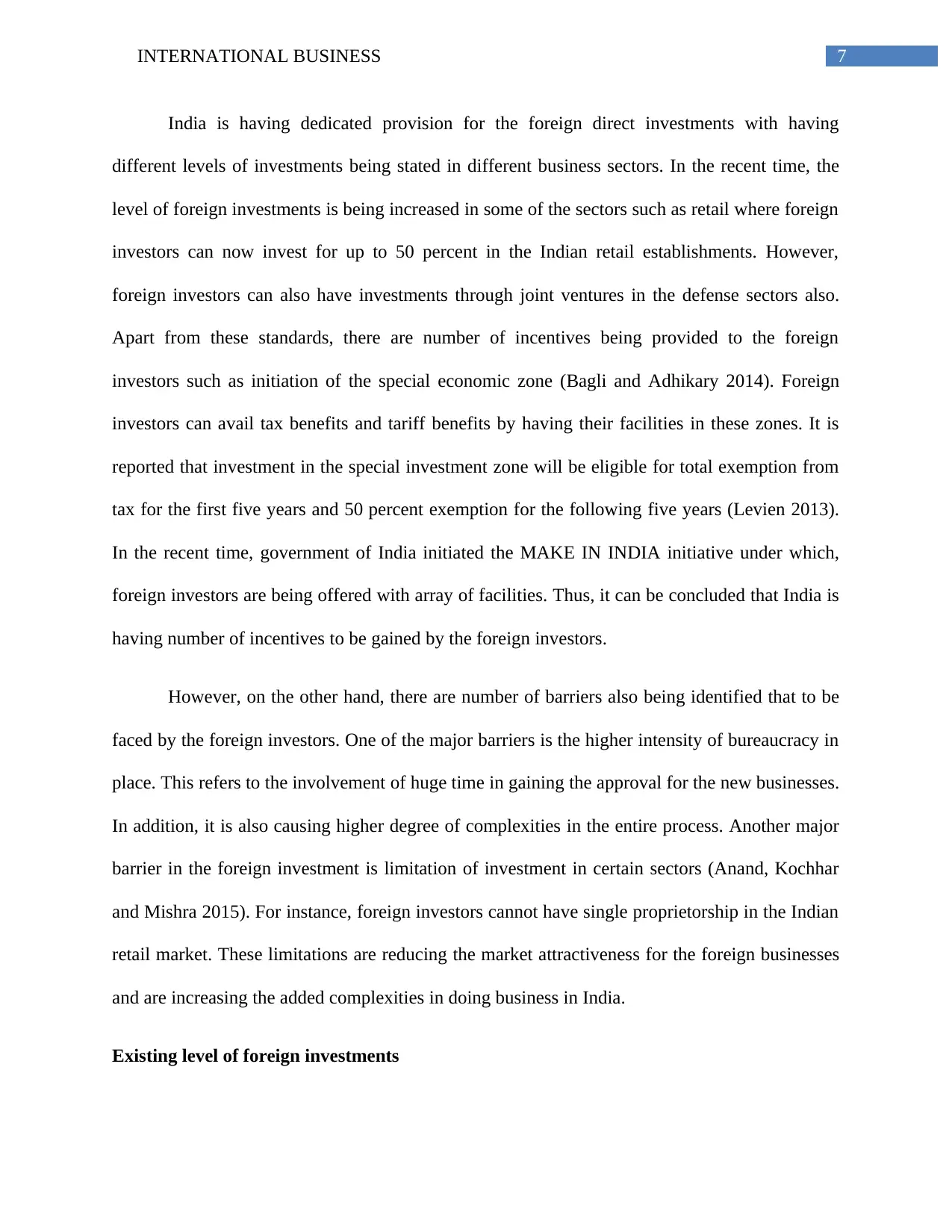
7INTERNATIONAL BUSINESS
India is having dedicated provision for the foreign direct investments with having
different levels of investments being stated in different business sectors. In the recent time, the
level of foreign investments is being increased in some of the sectors such as retail where foreign
investors can now invest for up to 50 percent in the Indian retail establishments. However,
foreign investors can also have investments through joint ventures in the defense sectors also.
Apart from these standards, there are number of incentives being provided to the foreign
investors such as initiation of the special economic zone (Bagli and Adhikary 2014). Foreign
investors can avail tax benefits and tariff benefits by having their facilities in these zones. It is
reported that investment in the special investment zone will be eligible for total exemption from
tax for the first five years and 50 percent exemption for the following five years (Levien 2013).
In the recent time, government of India initiated the MAKE IN INDIA initiative under which,
foreign investors are being offered with array of facilities. Thus, it can be concluded that India is
having number of incentives to be gained by the foreign investors.
However, on the other hand, there are number of barriers also being identified that to be
faced by the foreign investors. One of the major barriers is the higher intensity of bureaucracy in
place. This refers to the involvement of huge time in gaining the approval for the new businesses.
In addition, it is also causing higher degree of complexities in the entire process. Another major
barrier in the foreign investment is limitation of investment in certain sectors (Anand, Kochhar
and Mishra 2015). For instance, foreign investors cannot have single proprietorship in the Indian
retail market. These limitations are reducing the market attractiveness for the foreign businesses
and are increasing the added complexities in doing business in India.
Existing level of foreign investments
India is having dedicated provision for the foreign direct investments with having
different levels of investments being stated in different business sectors. In the recent time, the
level of foreign investments is being increased in some of the sectors such as retail where foreign
investors can now invest for up to 50 percent in the Indian retail establishments. However,
foreign investors can also have investments through joint ventures in the defense sectors also.
Apart from these standards, there are number of incentives being provided to the foreign
investors such as initiation of the special economic zone (Bagli and Adhikary 2014). Foreign
investors can avail tax benefits and tariff benefits by having their facilities in these zones. It is
reported that investment in the special investment zone will be eligible for total exemption from
tax for the first five years and 50 percent exemption for the following five years (Levien 2013).
In the recent time, government of India initiated the MAKE IN INDIA initiative under which,
foreign investors are being offered with array of facilities. Thus, it can be concluded that India is
having number of incentives to be gained by the foreign investors.
However, on the other hand, there are number of barriers also being identified that to be
faced by the foreign investors. One of the major barriers is the higher intensity of bureaucracy in
place. This refers to the involvement of huge time in gaining the approval for the new businesses.
In addition, it is also causing higher degree of complexities in the entire process. Another major
barrier in the foreign investment is limitation of investment in certain sectors (Anand, Kochhar
and Mishra 2015). For instance, foreign investors cannot have single proprietorship in the Indian
retail market. These limitations are reducing the market attractiveness for the foreign businesses
and are increasing the added complexities in doing business in India.
Existing level of foreign investments
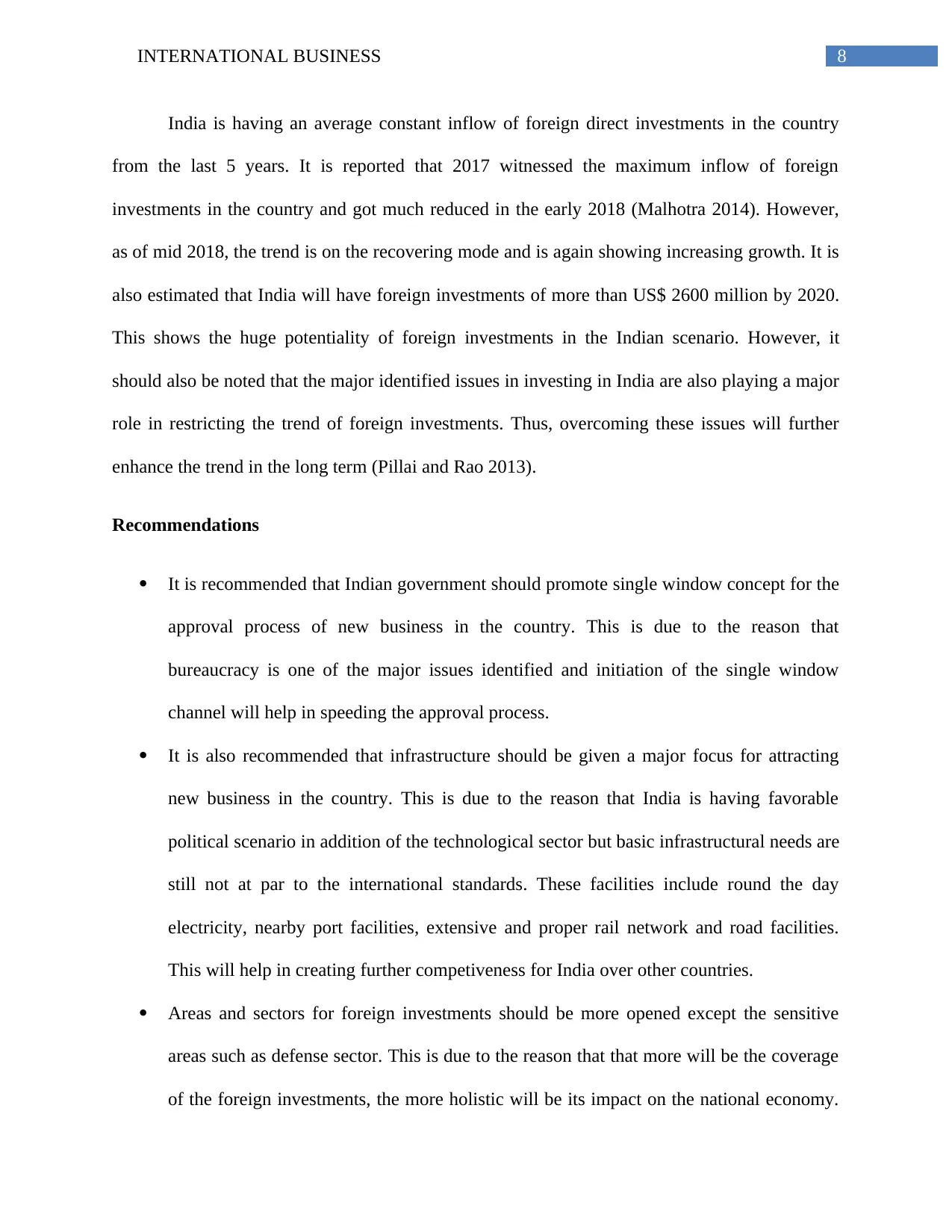
8INTERNATIONAL BUSINESS
India is having an average constant inflow of foreign direct investments in the country
from the last 5 years. It is reported that 2017 witnessed the maximum inflow of foreign
investments in the country and got much reduced in the early 2018 (Malhotra 2014). However,
as of mid 2018, the trend is on the recovering mode and is again showing increasing growth. It is
also estimated that India will have foreign investments of more than US$ 2600 million by 2020.
This shows the huge potentiality of foreign investments in the Indian scenario. However, it
should also be noted that the major identified issues in investing in India are also playing a major
role in restricting the trend of foreign investments. Thus, overcoming these issues will further
enhance the trend in the long term (Pillai and Rao 2013).
Recommendations
It is recommended that Indian government should promote single window concept for the
approval process of new business in the country. This is due to the reason that
bureaucracy is one of the major issues identified and initiation of the single window
channel will help in speeding the approval process.
It is also recommended that infrastructure should be given a major focus for attracting
new business in the country. This is due to the reason that India is having favorable
political scenario in addition of the technological sector but basic infrastructural needs are
still not at par to the international standards. These facilities include round the day
electricity, nearby port facilities, extensive and proper rail network and road facilities.
This will help in creating further competiveness for India over other countries.
Areas and sectors for foreign investments should be more opened except the sensitive
areas such as defense sector. This is due to the reason that that more will be the coverage
of the foreign investments, the more holistic will be its impact on the national economy.
India is having an average constant inflow of foreign direct investments in the country
from the last 5 years. It is reported that 2017 witnessed the maximum inflow of foreign
investments in the country and got much reduced in the early 2018 (Malhotra 2014). However,
as of mid 2018, the trend is on the recovering mode and is again showing increasing growth. It is
also estimated that India will have foreign investments of more than US$ 2600 million by 2020.
This shows the huge potentiality of foreign investments in the Indian scenario. However, it
should also be noted that the major identified issues in investing in India are also playing a major
role in restricting the trend of foreign investments. Thus, overcoming these issues will further
enhance the trend in the long term (Pillai and Rao 2013).
Recommendations
It is recommended that Indian government should promote single window concept for the
approval process of new business in the country. This is due to the reason that
bureaucracy is one of the major issues identified and initiation of the single window
channel will help in speeding the approval process.
It is also recommended that infrastructure should be given a major focus for attracting
new business in the country. This is due to the reason that India is having favorable
political scenario in addition of the technological sector but basic infrastructural needs are
still not at par to the international standards. These facilities include round the day
electricity, nearby port facilities, extensive and proper rail network and road facilities.
This will help in creating further competiveness for India over other countries.
Areas and sectors for foreign investments should be more opened except the sensitive
areas such as defense sector. This is due to the reason that that more will be the coverage
of the foreign investments, the more holistic will be its impact on the national economy.
⊘ This is a preview!⊘
Do you want full access?
Subscribe today to unlock all pages.

Trusted by 1+ million students worldwide
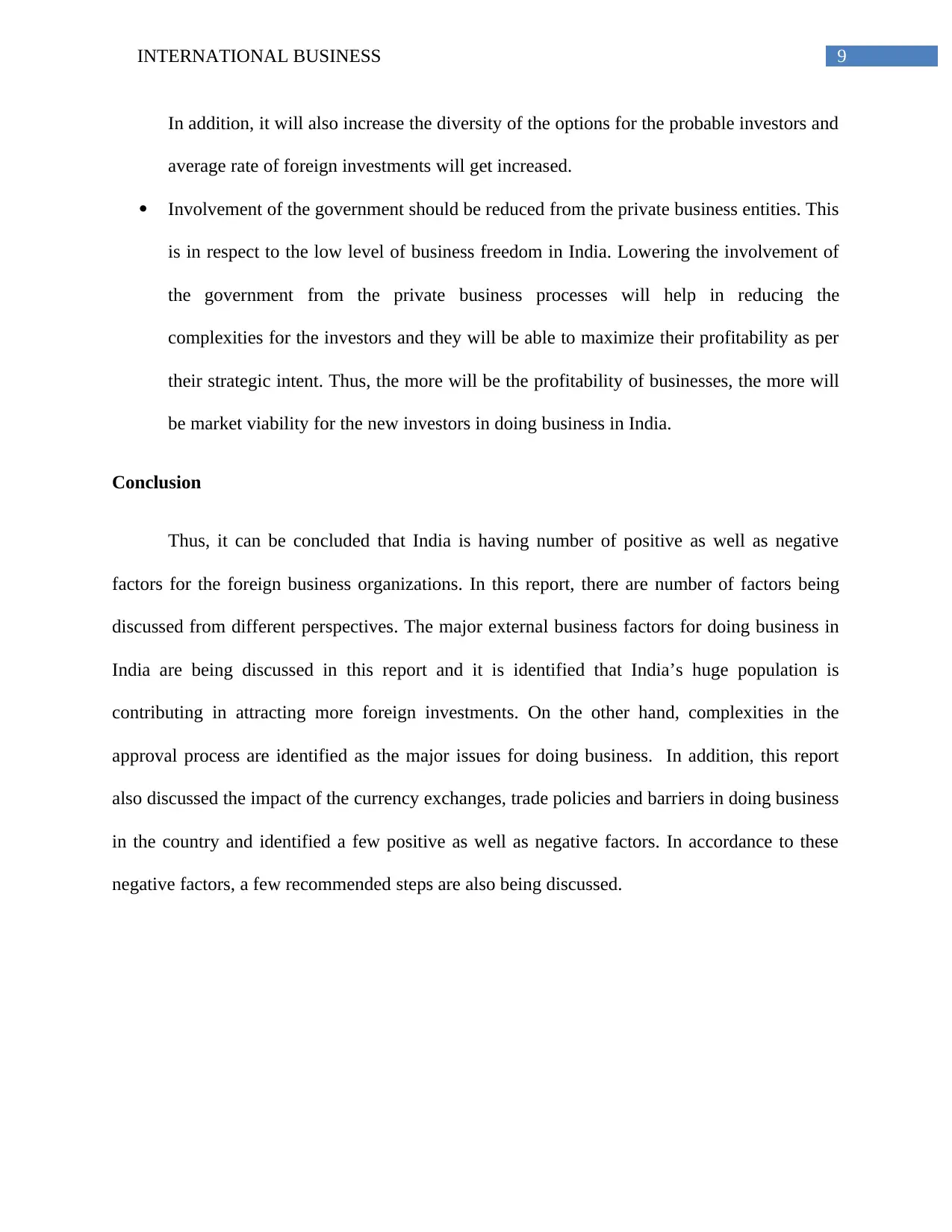
9INTERNATIONAL BUSINESS
In addition, it will also increase the diversity of the options for the probable investors and
average rate of foreign investments will get increased.
Involvement of the government should be reduced from the private business entities. This
is in respect to the low level of business freedom in India. Lowering the involvement of
the government from the private business processes will help in reducing the
complexities for the investors and they will be able to maximize their profitability as per
their strategic intent. Thus, the more will be the profitability of businesses, the more will
be market viability for the new investors in doing business in India.
Conclusion
Thus, it can be concluded that India is having number of positive as well as negative
factors for the foreign business organizations. In this report, there are number of factors being
discussed from different perspectives. The major external business factors for doing business in
India are being discussed in this report and it is identified that India’s huge population is
contributing in attracting more foreign investments. On the other hand, complexities in the
approval process are identified as the major issues for doing business. In addition, this report
also discussed the impact of the currency exchanges, trade policies and barriers in doing business
in the country and identified a few positive as well as negative factors. In accordance to these
negative factors, a few recommended steps are also being discussed.
In addition, it will also increase the diversity of the options for the probable investors and
average rate of foreign investments will get increased.
Involvement of the government should be reduced from the private business entities. This
is in respect to the low level of business freedom in India. Lowering the involvement of
the government from the private business processes will help in reducing the
complexities for the investors and they will be able to maximize their profitability as per
their strategic intent. Thus, the more will be the profitability of businesses, the more will
be market viability for the new investors in doing business in India.
Conclusion
Thus, it can be concluded that India is having number of positive as well as negative
factors for the foreign business organizations. In this report, there are number of factors being
discussed from different perspectives. The major external business factors for doing business in
India are being discussed in this report and it is identified that India’s huge population is
contributing in attracting more foreign investments. On the other hand, complexities in the
approval process are identified as the major issues for doing business. In addition, this report
also discussed the impact of the currency exchanges, trade policies and barriers in doing business
in the country and identified a few positive as well as negative factors. In accordance to these
negative factors, a few recommended steps are also being discussed.
Paraphrase This Document
Need a fresh take? Get an instant paraphrase of this document with our AI Paraphraser
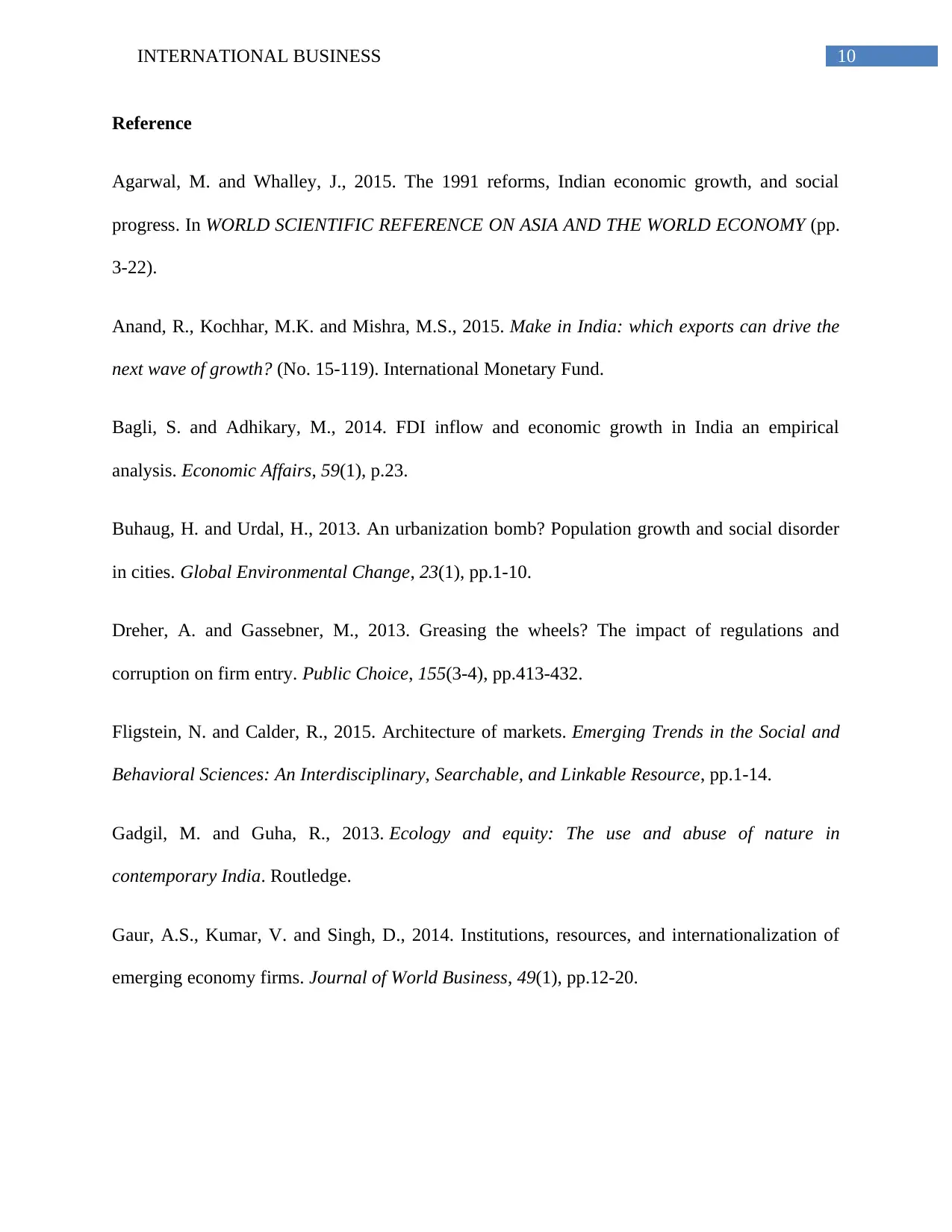
10INTERNATIONAL BUSINESS
Reference
Agarwal, M. and Whalley, J., 2015. The 1991 reforms, Indian economic growth, and social
progress. In WORLD SCIENTIFIC REFERENCE ON ASIA AND THE WORLD ECONOMY (pp.
3-22).
Anand, R., Kochhar, M.K. and Mishra, M.S., 2015. Make in India: which exports can drive the
next wave of growth? (No. 15-119). International Monetary Fund.
Bagli, S. and Adhikary, M., 2014. FDI inflow and economic growth in India an empirical
analysis. Economic Affairs, 59(1), p.23.
Buhaug, H. and Urdal, H., 2013. An urbanization bomb? Population growth and social disorder
in cities. Global Environmental Change, 23(1), pp.1-10.
Dreher, A. and Gassebner, M., 2013. Greasing the wheels? The impact of regulations and
corruption on firm entry. Public Choice, 155(3-4), pp.413-432.
Fligstein, N. and Calder, R., 2015. Architecture of markets. Emerging Trends in the Social and
Behavioral Sciences: An Interdisciplinary, Searchable, and Linkable Resource, pp.1-14.
Gadgil, M. and Guha, R., 2013. Ecology and equity: The use and abuse of nature in
contemporary India. Routledge.
Gaur, A.S., Kumar, V. and Singh, D., 2014. Institutions, resources, and internationalization of
emerging economy firms. Journal of World Business, 49(1), pp.12-20.
Reference
Agarwal, M. and Whalley, J., 2015. The 1991 reforms, Indian economic growth, and social
progress. In WORLD SCIENTIFIC REFERENCE ON ASIA AND THE WORLD ECONOMY (pp.
3-22).
Anand, R., Kochhar, M.K. and Mishra, M.S., 2015. Make in India: which exports can drive the
next wave of growth? (No. 15-119). International Monetary Fund.
Bagli, S. and Adhikary, M., 2014. FDI inflow and economic growth in India an empirical
analysis. Economic Affairs, 59(1), p.23.
Buhaug, H. and Urdal, H., 2013. An urbanization bomb? Population growth and social disorder
in cities. Global Environmental Change, 23(1), pp.1-10.
Dreher, A. and Gassebner, M., 2013. Greasing the wheels? The impact of regulations and
corruption on firm entry. Public Choice, 155(3-4), pp.413-432.
Fligstein, N. and Calder, R., 2015. Architecture of markets. Emerging Trends in the Social and
Behavioral Sciences: An Interdisciplinary, Searchable, and Linkable Resource, pp.1-14.
Gadgil, M. and Guha, R., 2013. Ecology and equity: The use and abuse of nature in
contemporary India. Routledge.
Gaur, A.S., Kumar, V. and Singh, D., 2014. Institutions, resources, and internationalization of
emerging economy firms. Journal of World Business, 49(1), pp.12-20.
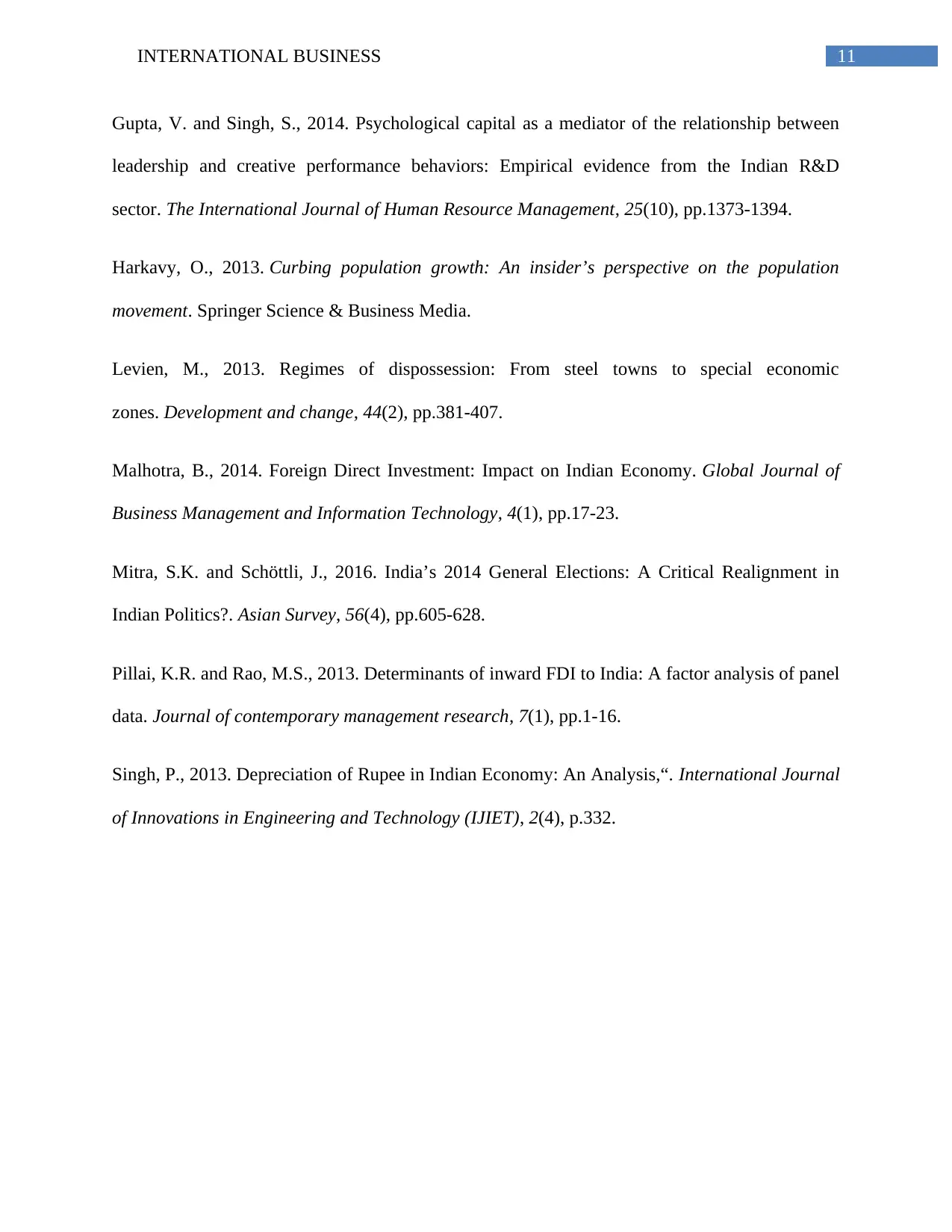
11INTERNATIONAL BUSINESS
Gupta, V. and Singh, S., 2014. Psychological capital as a mediator of the relationship between
leadership and creative performance behaviors: Empirical evidence from the Indian R&D
sector. The International Journal of Human Resource Management, 25(10), pp.1373-1394.
Harkavy, O., 2013. Curbing population growth: An insider’s perspective on the population
movement. Springer Science & Business Media.
Levien, M., 2013. Regimes of dispossession: From steel towns to special economic
zones. Development and change, 44(2), pp.381-407.
Malhotra, B., 2014. Foreign Direct Investment: Impact on Indian Economy. Global Journal of
Business Management and Information Technology, 4(1), pp.17-23.
Mitra, S.K. and Schöttli, J., 2016. India’s 2014 General Elections: A Critical Realignment in
Indian Politics?. Asian Survey, 56(4), pp.605-628.
Pillai, K.R. and Rao, M.S., 2013. Determinants of inward FDI to India: A factor analysis of panel
data. Journal of contemporary management research, 7(1), pp.1-16.
Singh, P., 2013. Depreciation of Rupee in Indian Economy: An Analysis,“. International Journal
of Innovations in Engineering and Technology (IJIET), 2(4), p.332.
Gupta, V. and Singh, S., 2014. Psychological capital as a mediator of the relationship between
leadership and creative performance behaviors: Empirical evidence from the Indian R&D
sector. The International Journal of Human Resource Management, 25(10), pp.1373-1394.
Harkavy, O., 2013. Curbing population growth: An insider’s perspective on the population
movement. Springer Science & Business Media.
Levien, M., 2013. Regimes of dispossession: From steel towns to special economic
zones. Development and change, 44(2), pp.381-407.
Malhotra, B., 2014. Foreign Direct Investment: Impact on Indian Economy. Global Journal of
Business Management and Information Technology, 4(1), pp.17-23.
Mitra, S.K. and Schöttli, J., 2016. India’s 2014 General Elections: A Critical Realignment in
Indian Politics?. Asian Survey, 56(4), pp.605-628.
Pillai, K.R. and Rao, M.S., 2013. Determinants of inward FDI to India: A factor analysis of panel
data. Journal of contemporary management research, 7(1), pp.1-16.
Singh, P., 2013. Depreciation of Rupee in Indian Economy: An Analysis,“. International Journal
of Innovations in Engineering and Technology (IJIET), 2(4), p.332.
⊘ This is a preview!⊘
Do you want full access?
Subscribe today to unlock all pages.

Trusted by 1+ million students worldwide
1 out of 12
Related Documents
Your All-in-One AI-Powered Toolkit for Academic Success.
+13062052269
info@desklib.com
Available 24*7 on WhatsApp / Email
![[object Object]](/_next/static/media/star-bottom.7253800d.svg)
Unlock your academic potential
Copyright © 2020–2025 A2Z Services. All Rights Reserved. Developed and managed by ZUCOL.





